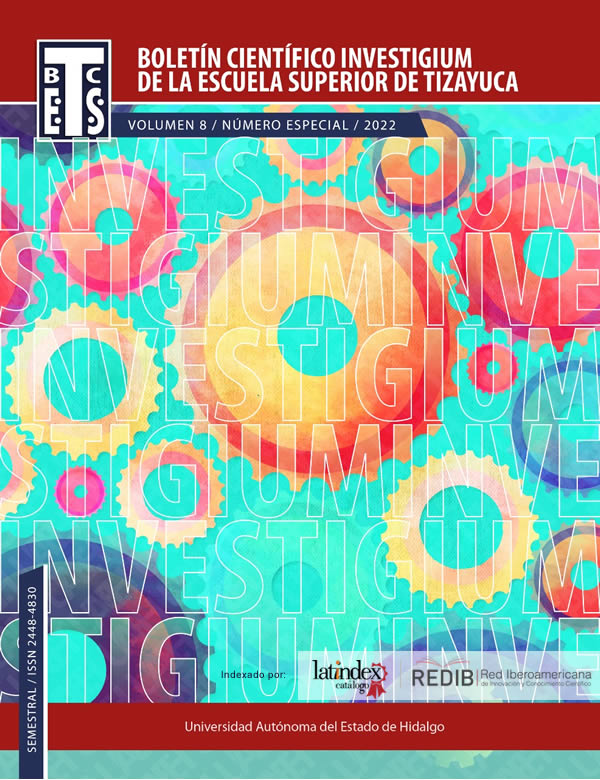Análisis trimestral de la fluctuación para el Ozono de la estación Merced de la Red Automática de Monitoreo Atmosférico de la Ciudad de México
DOI:
https://doi.org/10.29057/est.v8iEspecial.9841Palabras clave:
Ozono O3, exponente de Hurst, persistencia, función de estructuraResumen
En este trabajo se muestra la tendencia de escala de las fluctuaciones de registros de concentración contaminante del aire tomados de la estación de monitoreo Merced (MER) de la zona metropolitana del valle de México (ZMVM). La función de estructura de orden dos es usada como una medida para establecer la tendencia de los registros mediante el exponente de Hurst H. Se utilizaron cuatro series temporales de por año durante el período de 2010 a 2018. Se encontró que las fluctuaciones de obedecen un comportamiento de ley de potencia, donde se obtiene perstistencia estadística para los tres primeros trimestres y antipersistencia para el último trimestre.
Descargas
Citas
“Air quality guidelines for particulate matter, ozone, nitrogen dioxide and sulfur dioxide.” https://www.who.int/publications/i/item/WHO-SDE-PHE-OEH-06-02 (accessed Sep. 01, 2022).
“Air pollution.” https://www.who.int/health-topics/air-pollution#tab=tab_1 (accessed Sep. 01, 2022).
“OECD Environmental Outlook to 2050: The Consequences of Inaction - Key Facts and Figures - OECD.” https://www.oecd.org/env/indicators-modelling-outlooks/oecdenvironmentaloutlookto2050theconsequencesofinaction-keyfactsandfigures.htm (accessed Sep. 01, 2022).
C. A. Varotsos, J. M. Ondov, A. P. Cracknell, M. N. Efstathiou, and M. N. Assimakopoulos, “Long‐range persistence in global Aerosol Index dynamics,” undefined, vol. 27, no. 16, pp. 3593–3603, Aug. 2006, doi: 10.1080/01431160600617236.
C. A. Varotsos, J. M. Ondov, M. N. Efstathiou, and A. P. Cracknell, “The local and regional atmospheric oxidants at Athens (Greece),” Environ Sci Pollut Res Int, vol. 21, no. 6, pp. 4430–4440, 2014, doi: 10.1007/S11356-013-2387-1.
H. L. Windsor and R. Toumi, “Scaling and persistence of UK pollution,” Atmos Environ, vol. 35, no. 27, pp. 4545–4556, Sep. 2001, doi: 10.1016/S1352-2310(01)00208-4.
I. A. Pérez, M. L. Sánchez, M. A. García, and V. Paredes, “Persistence analysis of CO2 concentrations recorded at a rural site in the upper Spanish plateau,” Atmos Res, vol. 100, no. 1, pp. 45–50, Apr. 2011, doi: 10.1016/J.ATMOSRES.2010.12.025.
A. B. Chelani, “Statistical persistence analysis of hourly ground level ozone concentrations in Delhi,” Atmos Res, vol. 92, no. 2, pp. 244–250, Apr. 2009, doi: 10.1016/J.ATMOSRES.2008.12.001.
Z. Chen, C. P. Barros, and L. A. Gil-Alana, “The persistence of air pollution in four mega-cities of China,” Habitat Int, vol. 56, pp. 103–108, Aug. 2016, doi: 10.1016/J.HABITATINT.2016.05.004.
D. M. Bon et al., “Measurements of volatile organic compounds at a suburban ground site (T1) in Mexico City during the MILAGRO 2006 campaign: measurement comparison, emission ratios, and source attribution,” undefined, vol. 11, no. 6, pp. 2399–2421, 2010, doi: 10.5194/ACP-11-2399-2011.
W. Lei, G. Li, and L. T. Molina, “Modeling the impacts of biomass burning on air quality in and around Mexico City,” Atmos Chem Phys, vol. 13, no. 5, pp. 2299–2319, 2013, doi: 10.5194/ACP-13-2299-2013.
G. Li et al., “Atmospheric Chemistry and Physics Impacts of HONO sources on the photochemistry in Mexico City during the MCMA-2006/MILAGO Campaign,” Atmos. Chem. Phys, vol. 10, pp. 6551–6567, 2010, doi: 10.5194/acp-10-6551-2010.
S. Orta-García, F. Pérez-Vázquez, C. González-Vega, J. A. Varela-Silva, L. Hernández-González, and I. Pérez-Maldonado, “Concentrations of persistent organic pollutants (POPs) in human blood samples from Mexico City, Mexico,” Science of The Total Environment, vol. 472, pp. 496–501, Feb. 2014, doi: 10.1016/J.SCITOTENV.2013.11.059.
M. L. Bell, D. L. Davis, N. Gouveia, V. H. Borja-Aburto, and L. A. Cifuentes, “The avoidable health effects of air pollution in three Latin American cities: Santiago, São Paulo, and Mexico City,” Environ Res, vol. 100, no. 3, pp. 431–440, Mar. 2006, doi: 10.1016/J.ENVRES.2005.08.002.
H. Riojas-Rodríguez et al., “Personal PM2.5 and CO exposures and heart rate variability in subjects with known ischemic heart disease in Mexico City,” J Expo Sci Environ Epidemiol, vol. 16, no. 2, pp. 131–137, Mar. 2006, doi: 10.1038/SJ.JEA.7500453.
M. Meraz, E. Rodriguez, R. Femat, J. C. Echeverria, and J. Alvarez-Ramirez, “Statistical persistence of air pollutants (O3,SO2,NO2 and PM10) in Mexico City,” Physica A: Statistical Mechanics and its Applications, vol. 427, pp. 202–217, Jun. 2015, doi: 10.1016/j.physa.2015.02.009.
D. Aguilar-Velázquez and I. Reyes-Ramírez, “A wavelet analysis of multiday extreme ozone and its precursors in Mexico city during 2015-2016,” 2018, doi: 10.1016/j.atmosenv.2018.06.017.
A. Sanchez, “Complejidad :: mecánica estadística y ciencia no lineal,” SeMA Journal: Boletín de la Sociedad Española de Matemática Aplicada, ISSN 2254-3902, ISSN-e 2254-3902, No. 34, 2006, págs. 175-189, no. 34, pp. 175–189, 2006, Accessed: Sep. 01, 2022. [Online]. Available: https://dialnet.unirioja.es/servlet/articulo?codigo=2317062
B. B. Mandelbrot, “Fractals and Scaling in Finance,” Fractals and Scaling in Finance, 1997, doi: 10.1007/978-1-4757-2763-0.
Z. Eisler, I. Bartos, and J. Kertész, “Fluctuation scaling in complex systems: Taylor’s law and beyond,” Adv Phys, vol. 57, no. 1, pp. 89–142, Aug. 2007, doi: 10.48550/arxiv.0708.2053.
A. S. Balankin, “Dynamic scaling approach to study time series fluctuations,” Phys Rev E Stat Nonlin Soft Matter Phys, vol. 76, no. 5 Pt 2, Nov. 2007, doi: 10.1103/PHYSREVE.76.056120.
A. S. Balankin, D. Morales Matamoros, J. Patiño Ortiz, M. Patiño Ortiz, E. Pineda León, and D. Samayoa Ochoa, “Scaling dynamics of seismic activity fluctuations,” Europhys Lett, vol. 85, no. 3, p. 39001, Feb. 2009, doi: 10.1209/0295-5075/85/39001.
A. L. Barabsi and T. Vicsek, “Multifractality of self-affine fractals,” Phys Rev A (Coll Park), vol. 44, no. 4, p. 2730, Aug. 1991, doi: 10.1103/PhysRevA.44.2730.
P. Meakin, “Fractals, scaling, and growth far from equilibrium,” p. 674, 1998, Accessed: Sep. 01, 2022. [Online]. Available: https://books.google.com/books/about/Fractals_Scaling_and_Growth_Far_from_Equ.html?hl=es&id=cWmbNYSQDKoC
H.-O. Peitgen, H. Jürgens, and D. Saupe, “Chaos and Fractals,” Chaos and Fractals, 1992, doi: 10.1007/978-1-4757-4740-9.
Y. H. Shao, G. F. Gu, Z. Q. Jiang, W. X. Zhou, and D. Sornette, “Comparing the performance of FA, DFA and DMA using different synthetic long-range correlated time series,” Sci Rep, vol. 2, 2012, doi: 10.1038/SREP00835.
K. Hu, P. C. Ivanov, Z. Chen, P. Carpena, and H. E. Stanley, “Effect of trends on detrended fluctuation analysis,” Phys Rev E, vol. 64, no. 1, p. 011114, Jun. 2001, doi: 10.1103/PhysRevE.64.011114.


















